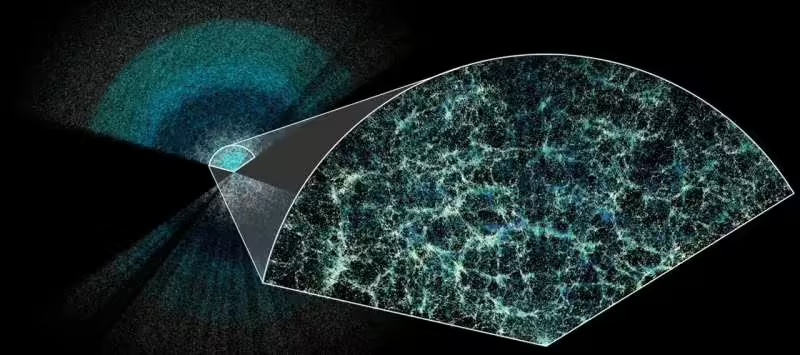New model shows that the color of a galaxy tells its distance
- July 15, 2024
- 0
A team at Ludwig Maximilian University (LMU) has created a model to discover what the color of a galaxy tells us about its distance, and to use this
A team at Ludwig Maximilian University (LMU) has created a model to discover what the color of a galaxy tells us about its distance, and to use this

A team at Ludwig Maximilian University (LMU) has created a model to discover what the color of a galaxy tells us about its distance, and to use this to measure cosmic structures. Our universe is about 13.8 billion years old. During that time, the smallest initial asymmetries have evolved into the large-scale structures we can see with our telescopes in the night sky: galaxies like the Milky Way, clusters of galaxies, and even larger clumps of matter or filaments of gas and dust.
The pace of this growth, at least in the modern universe, depends on some kind of struggle between natural forces: Will dark matter, which holds everything together with its gravity and attracts additional matter, be able to counteract dark energy, which is pushing the universe further apart?
“We can observe this struggle if we can measure structures in the sky accurately,” says LMU astrophysicist Daniel Grün.
This is where telescopic observation projects that record large areas of the sky in very accurate images come to the rescue. For example, there are dark energy studies with the Blanco telescope in Chile and the newly launched Euclid satellite. LMU scientists have been involved in both projects for many years, including in leadership positions.
Determining the exact distance of individual structures and galaxies from us is not always easy, but it is crucial. After all, the farther away a galaxy is, the longer its light has to travel to us, so the older the picture of the universe that we get from observing it. One important source of information is the observed color of a galaxy, as measured by ground-based telescopes such as Blanco or satellites such as Euclid.
New research from a team led by Jamie McCullough and Daniel Grün has been published in the journal Monthly Notices of the Royal Astronomical Societyanalyzed the largest dataset to date and shed light on what the colors of different galaxies actually tell us about their true distances.
In principle, the distance to a galaxy can be accurately determined using spectroscopy. This involves measuring the spectral lines of distant galaxies. Since the universe as a whole is expanding, the wavelengths appear to be longer as the galaxy moves away from us. This is because the light waves from distant galaxies extend all the way to us.
This effect, known as redshift, also changes the apparent colors measured by instruments in the galaxy image. They appear redder than they actually are. This is similar to the Doppler effect we hear in the siren of an ambulance as it passes us and then moves away.
Jamie McCullough is a postdoctoral researcher at LMU and Stanford University. For his analysis, he used spectroscopic measurements from the Dark Energy Spectroscopic Instrument (DESI) together with the largest dataset to date (KiDS-VIKING) for precise measurements of galaxy colors.
Specifically, the authors combined DESI spectroscopic data for 230,000 galaxies with galaxy colors from the KiDS-VIKING survey and used this information to determine the relationship between a galaxy’s distance from us and its observed color and brightness. No two galaxies in the universe are alike, but for each class of similar galaxies there is a unique relationship between observed color and redshift.
“If we can combine distance information with measurements of galaxy shapes, we can infer large-scale structure based on light distortions,” says Jamie McCullough.
The results of the study make it possible to statistically determine the true distance of each galaxy observed in images taken by Euclid or the Dark Energy Survey.
By analyzing distortions observed in images of galaxies, scientists can learn and better understand the behavior of cosmic structures today and billions of years ago. This will make it possible to understand the evolutionary history of the universe.
You don’t have to wait billions of years to watch a structure form over time; you just have to measure it at different distances from Earth. This is nearly impossible in the images themselves, because you can’t tell the distance of a galaxy to ours simply by how it looks in the image. Jamie McCullough’s research holds the key to this question by creating a model of what the apparent “color” of a galaxy tells us about its distance.
The main purpose of this precise observation and distribution of galaxies at different distances is to gain insight into the great struggle between the natural forces of dark matter and dark energy.
“You need to be able to watch individual rounds of that game to really see what’s going on,” Gruen says. That’s because dark energy is poised to capture and potentially stop the formation of larger concentrations of mass in the universe.
“Only then will we understand what dark matter and dark energy really are and which one will ultimately win out.”
Source: Port Altele
As an experienced journalist and author, Mary has been reporting on the latest news and trends for over 5 years. With a passion for uncovering the stories behind the headlines, Mary has earned a reputation as a trusted voice in the world of journalism. Her writing style is insightful, engaging and thought-provoking, as she takes a deep dive into the most pressing issues of our time.